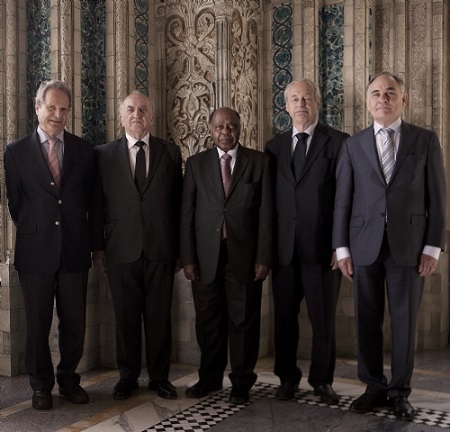No amount of China’s protestation that the Oct 29 decision of the United Nations Arbitral Tribunal is “null and void” and it has “no binding effect” on them, cancels the fact that it’s a major blow to them.
Filipinos, on the other hand, should understand that the U.N. Arbitral Court’s decision, although a win for the country, does not award the disputed islands and waters of Spratlys to the Philippines.
That’s precisely because that is not what the Philippines asked from the U.N. Arbitral Tribunal when it filed the case against China on Jan. 22, 2013.

Members of the Tribunal: Judge Thomas A. Mensah of Ghana, president; Judge Jean-Pierre Cot of
France; Judge Stanislaw Pawlak of Poland; Professor Alfred Soons of the Netherlands; and Judge Rüdiger
Wolfrum of Germany.
What the Philippines asked the Tribunal concerned three basic issues: rule on the validity of China’s nine-dash line map; low tide elevations (rocks or reefs that can be seen only during low tide and disappear during high tide) where China has built permanent structures should be declared as forming part of the Philippine Continental shelf (200 nautical mile); and the waters outside the 12 nautical miles surrounding the Panatag Island (Scarbourough shoal) should be declared as part of the Philippines 200 nautical mile economic exclusive zone.
China questioned the jurisdiction of the Arbitral Tribunal saying the issues raised by the Philippines are territorial matters and are beyond the interpretation of the U.N. Convention of the Law of the Sea, which is the role of the tribunal.
Territorial issues – who has sovereignty over disputed territories- is the province of the International Court of Justice which requires that both parties agree to bring the issue to the court for resolution. Since China refused to bring the issue for international arbitration, the Philippines wisely opted to go to the UNCLOS Arbitral Tribunal.
In its decision, the Court stated: “Conscious that the Convention is not concerned with territorial disputes, the Philippines has stated at all stages of this arbitration that it is not asking this Tribunal to rule on the territorial sovereignty aspect of its disputes with China. Similarly, conscious that in 2006 China made a declaration, in accordance with the Convention, to exclude maritime boundary delimitations from its acceptance of compulsory dispute settlement procedures under the Convention, the Philippines has stated that it is not asking this Tribunal to delimit any maritime boundaries.
In its press release on the Award, the Court said, “This arbitration concerns the role of ‘historic rights’ and the source of maritime entitlements in the South China Sea, the status of certain maritime features in the South China Sea and the maritime entitlements they are capable of generating, and the lawfulness of certain actions by China in the South China Sea that are alleged by the Philippines to violate the Convention.”
The Tribunal said the decision was “unanimous” and underscored that it “concerns only whether it has jurisdiction to consider the Philippines’ claims and whether such claims are admissible.”
“The Award does not decide any aspect of the merits of the Parties’ dispute,” the statement said.
That judgment will come after the hearings where the Philippines will argue on the merits of its submissions. The Philippines’ American lawyer, Paul Reichler, has been quoted as saying that the decision may come mid-2016.
In its press statement, the Tribunal said, “In its Award, the Tribunal has held that both the Philippines and China are parties to the Convention and bound by its provisions on the settlement of disputes. The Tribunal has also held that China’s decision not to participate in these proceedings does not deprive the Tribunal of jurisdiction and that the Philippines’ decision to commence arbitration unilaterally was not an abuse of the Convention’s dispute settlement procedures. “
The Tribunal dismissed the arguments stated by China in its position paper that was not officially submitted but nevertheless, considered by the Court. It said, “Reviewing the claims submitted by the Philippines, the Tribunal has rejected the argument set out in China’s Position Paper that the Parties’ dispute is actually about sovereignty over the islands in the South China Sea and therefore beyond the Tribunal’s jurisdiction.
The Tribunal has also rejected the argument set out in China’s Position Paper that the Parties’ dispute is actually about the delimitation of a maritime boundary between them and therefore excluded from the Tribunal’s jurisdiction through a declaration made by China in 2006. On the contrary, the Tribunal has held that each of the Philippines’ Submissions reflect disputes between the two States concerning the interpretation or application of the Convention.
The Tribunal has also held that no other States are indispensable to the proceedings.”







